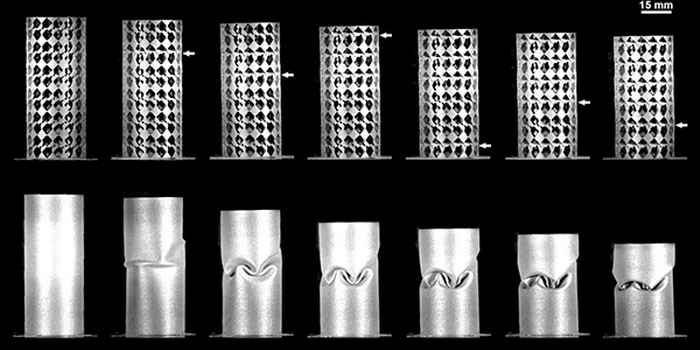Cars and other motorised vehicles are built in such a way that when they crash, their front-end crumples and any passengers inside don’t feel the full force of the impact. Researchers at the University of Amsterdam (UvA) and Tata Steel Nederland have created a unique shock absorber for use in just this kind of life-saving application: a ‘metamaterial’ that is stiff, lightweight and able to efficiently and repeatedly absorb shocks.

Elastic or plastic?
Understanding how materials respond under stress is one thing; controlling how they do so is another. To this end, metamaterials – lab-designed materials – use innovative design to attain beyond-natural material properties. This approach is key to finding the ideal shock absorber.
Many existing mechanical metamaterial designs rely on reversible elastic deformations, like those of a rubber band. While this allows the metamaterials to reliably return to their original shape after bending or stretching, it limits how stiff or strong they can be. But now the research team, led by UvA physicist Corentin Coulais, have demonstrated that metamaterials based on non-elastic materials make for ideal shock absorbers. In fact, they make it possible to combine two usually opposed properties: being stiff and able to carry sufficient weight on the one hand, and being supple or pliant enough to efficiently absorb sudden impacts on the other.

‘There is a large gap between most elastic metamaterials designed in the lab, and real applications which normally require high material stiffness and strength, especially in high-tech applications,’ says UvA researcher Wenfeng Liu, first author of the study. ‘Although plastic deformations have traditionally been carefully avoided in metamaterial design, because they were seen as ‘material failure’, our designs actually embrace plasticity.’
The new metamaterials were made using a 3D metal printer (and later also using traditional manufacturing methods), after which the researchers extensively crash-tested the superior shock absorption of the designs. To this end, they used a decades-old hydraulic crushing machine resurrected from the university’s Technology Centre, as well as a newly bought machine that can exert enormous forces (dubbed ‘Smashzilla’), and a three-storey industrial drop tower at Tata Steel Nederland.Creating the ideal shock absorber
https://youtu.be/umjSwx1m340
(Video by Caren Huygelen)
Layer-by-layer buckling
The new metamaterials strike a delicate balance. On the one hand, there is the plasticity of the base material; on the other, there is the flexibility of the geometric structures built from it. Together, these determine how easily the metamaterial yields under pressure. The result is metamaterials that buckle sequentially – they deform layer by layer – when struck. This unique, controlled buckling means that they can efficiently dissipate the impact energy while still being able to carry heavy loads.
The layer-by-layer buckling also means the shock absorbers can be used multiple times – until every layer has buckled – and even be stretched out again for a second life cycle. This is in stark contrast to traditional crumpling shock absorbers, which in the case of crumple zones in vehicles are usually made of sheets or cylinders of metal. Once these shock absorbers have buckled, they lose their initial stiffness and strength and can no longer be used to bear any load.

Another important element of the new class of metamaterials with sequential buckling is that they can be made of any so-called elastoplastic material (the category that most solid materials fall under). Moreover, they can be mass-produced, and the structural design can be adapted for a wide range of applications.
Bernard Ennis of Tata Steel Nederland adds: ‘Using this technology we can not only revolutionise shock absorption in automotive, aerospace and construction applications but also design precisely tailored materials at all size scales.’
Publication details
Wenfeng Liu, Shahram Janbaz, David Dykstra, Bernard Ennis and Corentin Coulais, Harnessing plasticity in sequential metamaterials for ideal shock absorption. Nature 634, 842–847 (2024). https://doi.org/10.1038/s41586-024-08037-0
